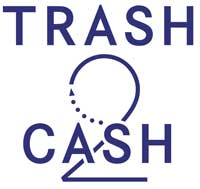| Nov 15, 2018 | |
Waste not, want not: making new materials from waste |
|
| (Nanowerk News) It is estimated that over 3 million tonnes of textile waste is discarded every year in the European Union. As well as energy and water, the textile industry is a major consumer of raw materials. Therefore, it is necessary to find urgent solutions for reducing waste in this sector and making better use of available resources as part of the EU’s transition towards a more circular economy. | |
 TRASH-2-CASH project logo The EU-funded TRASH-2-CASH project brought together a transdisciplinary team from 10 European countries to take a fresh look at the potential of recycling in this sector. The goal was to use design to produce innovative, high-end materials which could contribute to creating a circular, low-waste production cycle. ‘We have been working with a new methodology, design-driven material innovation (DDMI) that has allowed us to create a unique collaboration between designers, scientists and manufacturers,’ explains Emma Östmark, project coordinator. ‘This has enabled us to develop innovative state-of-the-art fibre-recycling methods to create new high-performance fibres with multiple possible applications.’ Innovation in the loop |
|
| By combining the unique skills of designers, scientists and producers, the project also developed a methodology through which the environmental performance of materials is integrated into the production process right from the start of the process, and the end-user is always kept in mind. | |
| The new materials produced as a result of TRASH-2-CASH are not only made from waste but are also created to be used appropriately and fully before re-entering the recycling process, thereby creating a closed loop. ‘In this scenario, the material life cycle is no longer cradle to grave, but cradle to cradle to cradle,’ notes Östmark. | |
| At a scientific level, the project has shifted the focus from mechanical to chemical recycling enabling the manufacture of higher-quality materials with a wider scope for their use – from textiles and plastics for the interiors of cars to high-fashion garments. | |
| TRASH-2-CASH has explored three emerging chemical recycling processes that relate primarily to cotton and polyester, which make up 80 % of fibres used globally. During the regeneration of cellulose to obtain Ioncell-F (CL) fibres, paper and cotton textile waste are converted into upcycled high-quality, high-end fibre. The de-repolymerisation process is applied to obtain recycled polyester (r-PET) fibres; while the melt mixing procedure produces r-PET pellets. | |
| Furthermore, the project team is proposing a new model whereby textile waste is recycled chemically to produce fabrics that are of the same quality as new materials and are used in the manufacture of materials that are industrially replicable and infinitely recyclable. Having provided proof of concept, through six ‘master cases’, the next step is for the project results to be scaled up to an industrial level and put into practice. | |
| Finally, TRASH-2-CASH has also pioneered a whole new approach to developing recyclable materials that clearly demonstrates the advantages of creative designers working closely with science and industry to create sustainable change and innovation. |
| Source: European Commission |
